#Marketing Channels
Explore tagged Tumblr posts
Text
Mastering Your Marketing The 7 Essential Steps for Crafting a Winning Strategy
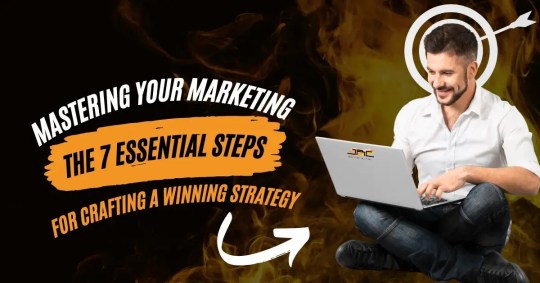
Introduction
In the dynamic and competitive landscape of business, a well-crafted marketing strategy is crucial for success. It’s more than just coming up with imaginative ideas, it involves a deep understanding of the market, competition, and the preferences of your target audience.
This article will explore the key components of a winning marketing strategy, providing a detailed, step-by-step guide to help you align your strategy with your business goals and objectives. We’ll also highlight the importance of tracking progress and making necessary adjustments to ensure ongoing relevance and effectiveness.
Step 1: Understand the Market and Target Audience
Understanding your market and target audience is the foundation of a successful marketing strategy. This involves extensive research into customer demographics, behavior, and competitive analysis.
Demographic Research
Demographic research entails a thorough analysis of customer characteristics such as age, gender, income, and location. By identifying key demographic factors, you can create a detailed profile of your ideal customer, enabling you to tailor your marketing efforts effectively. Techniques for demographic research include surveys, data analysis from websites and social media, and studying industry reports.
Types of Demographic Research
Age-Based Research
Analyzing data based on different age groups to tailor marketing efforts.
Gender-Based Research
Understanding gender preferences to create targeted campaigns.
Income-Based Research
Analyzing data based on income levels to customize messaging.
Geographical Research
Studying data based on location to identify optimal marketing locations.
Behavioral Study
Understanding customer behavior is crucial for building a successful marketing strategy. Behavioral study involves analyzing how customers interact with a brand, their purchasing habits, and decision-making processes.
Examples of Behavioral Study Methods
Purchase History Analysis
Examining past purchases to tailor marketing efforts.
Website Analytics
Analyzing website traffic, user engagement, and conversion rates.
Social Media Listening
Monitoring social media channels to understand customer sentiments.
Competitor Analysis
Beyond understanding your target audience, it’s essential to analyze the competition. Conducting a SWOT analysis (Strengths, Weaknesses, Opportunities, Threats) and benchmarking against competitors’ products, services, or processes provides valuable insights.

Step 2: Set Measurable Objectives
Once you understand your market and audience, the next step is to set measurable objectives. These objectives should be SMART: Specific, Measurable, Achievable, Relevant, and Time-bound.
Avoid common mistakes, such as setting vague or unrealistic objectives, to ensure your goals guide your marketing tactics effectively.
Breaking Down SMART Objectives
Specific
Clearly defining and articulating the objective.
Measurable
Establishing metrics for tracking and evaluation.
Achievable
Realistic goals within given resources.
Relevant
Aligning with the overall business strategy.
Time-Bound
Having a specific deadline or timeframe for completion.
Step 3: Develop a Messaging Framework
A messaging framework acts as a blueprint for consistent communication with your target audience across all channels. It includes key messages that communicate the unique value proposition of your brand.
Crafting an Effective Messaging Framework
Speak their Language
Tailor messages to resonate with your audience.
Highlight Benefits
Focus on positive outcomes rather than just features.
Consistency is Key
Ensure messages align with overall business strategy.
Step 4: Choose the Right Marketing Channels
Effectively promoting your product or service requires selecting the right marketing channels that resonate with your audience and align with your objectives.
Avoid the common mistake of spreading too thin across channels. Focus on the most effective ones for your target audience and goals.
Considerations for Choosing Marketing Channels
Know Your Audience
Understand where your audience spends time online.
Align with Objectives
Different channels suit different marketing objectives.
Budget and Resources
Choose channels feasible within your budget.
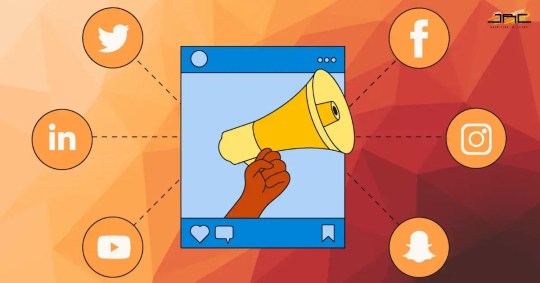
Step 5: Develop a Content Strategy
In today’s digital age, content is a cornerstone of any marketing strategy. A robust content strategy involves creating and distributing high-quality content to attract and engage your target audience.
Common mistakes include prioritizing quantity over quality and neglecting search engine optimization. Quality content builds trust and establishes your brand as a thought leader.
Building an Effective Content Strategy
Understand Audience Needs
Identify topics that resonate with your audience.
Choose Effective Formats
Tailor content formats to audience preferences.
Select Distribution Channels
Choose platforms where your audience is most active.
Step 6: Measure and Adjust
Creating a successful marketing strategy is an ongoing process that requires continuous monitoring and evaluation.
By tracking KPIs and analyzing data, you can identify effective tactics, make adjustments, and optimize future efforts.
Utilizing Key Performance Indicators (KPIs)
Website Traffic
Measure website visits.
Conversion Rates
Evaluate how well you convert leads.
Return on Investment (ROI)
Assess the profitability of your efforts.
Social Media Engagement
Track interaction on social platforms.
Customer Retention Rates
Measure customer loyalty.
Step 7: Embracing a Dynamic Approach
A successful marketing strategy should be dynamic, adapting to changing market conditions and customer needs.
Flexible Approach
Regular Analysis and Optimization
Conduct ongoing market research for up-to-date insights.
Adapt to Trends
Adjust strategies based on industry trends.
Crisis Preparedness
Be ready to adjust messaging during unexpected events.
Conclusion
A successful marketing strategy requires a deep understanding of your target audience and market. It should include measurable objectives, a cohesive messaging framework, and a well-defined content strategy leveraging appropriate marketing channels. Regular review and adaptation to changing market conditions and customer needs are crucial for long-term success. Remember, a winning marketing strategy is a fluid document that evolves over time, demanding continuous monitoring and adjustment.
Ready to step up your marketing game?
Want more tips for your business? Contact us now and let’s make your business stand out!
Ready to supercharge your marketing strategy with data-driven insights?
Explore Analytics and Reporting tools mentioned in this post, or reach out to our team for a free consultation on how to kickstart your data-driven marketing journey. Don’t miss out on the power of data – start making smarter marketing decisions today!
CONTACT NOW
#marketing strategies#digital marketing#search engine optimization#business marketing#marketing agency#online marketing#digital marketing agency#marketing#seo marketing#business strategy#marketing channels#content marketing#content strategy#competitive analysis#growth#search engine marketing
3 notes
·
View notes
Text

Holiday 2023 Outlook for Consumers and Marketers
Inflation has been on the decline for over a year, and in June it fell to 3% - the lowest rate recorded since March 2021. Coupled with this is a steady rise in consumer confidence, which in June hit a high not seen since early 2022. And even though these trends are a step in the right direction, economic uncertainty is still expected to play a large role in the purchasing decisions being made this holiday season. Price-conscious consumers will look to cut costs by shopping the sale section, using coupons, downsizing holiday celebrations, and simply buying fewer items. With so many brands competing for share of wallet, it won’t be enough to differentiate on price alone. Instead, brands should make a concerted effort to secure share of mind right now so that they are top of mind during the holidays and beyond.
At a high level, the best way to accomplish this is twofold. First, it’s critical to embrace an audience-first, channel-agnostic mindset so that you are reaching the right audience at the right time. Once you’ve found your audience, it’s important to meet them with strong messaging that is centered on brand value. In this article, we make the case for programmatic channels as effective marketing avenues for expanding brand reach and, ultimately, nurturing long-term brand favorability (i.e., when the holidays roll around).
Changing the Narrative on Programmatic Advertising
Let’s start with some housekeeping - when we talk about programmatic, we’re referring to a method for buying ads on specific channels, including Display, Video, Audio, and Digital Out of Home. Within each channel, there are myriad ways to target audiences based on interests, behaviors, device, location, and demographics.
“When you bring up programmatic to a performance marketer, you might see their eyes glaze over - they’re imagining annoying banner ads placed on low-quality inventory that don’t drive results,” says Erin Morningstar, Director of Strategy at New Engen. This attitude is pervasive and, according to Erin, informs the two primary reasons that brands are wary of investing in programmatic advertising: concerns about brand safety and equity, and limitations of measurement. These reservations are understandable, especially if you believe that programmatic is strictly used for generating brand awareness. But Erin explains that "programmatic is more than banner ads or dynamic product retargeting - it’s the turnkey option for accessing the wealth of ad inventory outside of walled gardens and paid search."
Teka Phan, Associate Director at New Engen, adds:
It’s important to understand that programmatic buying is performance buying. It powers actionable insights into how this media drives actions and conversions across the entire marketing funnel.
The reality of digital marketing in 2023 is that brands can’t successfully grow on the Meta-Google duopoly alone (the aforementioned walled gardens). Instead, it’s essential to meet your customers, both existing and prospective, where they are. This begs the question - where are they?
Media Consumption is Changing (Rapidly)
The channel landscape is more diverse than ever, and consumers are increasingly discovering brands through podcasts, in-app ads, and music streaming services. eMarketer predicts that, by 2024, 20% of all time spent consuming digital media will come from audio. What’s more, CTV already constitutes more than 25% of the time consumers spend with digital media, yet accounts for less than 10% of digital ad spending in the US. To put this in context, Meta receives roughly 20% of ad investment despite representing just 7.6% of all digital media consumption.
This is precisely why we, as an agency, believe that brands can win on channels like digital audio, CTV, and yes, even display. It’s true that direct-buying channels are often part of a mature media mix for many brands. But the benefit of embracing a programmatic-first approach is that it allows marketers to keep an eye on performance at scale while maintaining a direct buy approach for branding-first initiatives.
The Benefits of Investing in Programmatic
Thought leaders at New Engen have identified four primary benefits to investing in programmatic:
Control: Despite some preconceived notions, programmatic ad buying affords marketers tighter control over targeting, placements, and optimization. This level of control enables measurement testing in the form of geo holdouts, known audience split tests, and platform lift tools. Such exercises are critical to proving the value of channels outside of last-click.
Flexibility: Budgets can be seamlessly moved around across channels and publishers on a daily or even hourly basis. In contrast, brands buying directly from multiple publishers are beholden to more rigidity driven by campaign minimums and contract terms.
Value at Scale: Not only are CPMs generally cheaper when buying programmatically, but DSPs often provide access to a variety of inventory types, formats, and audiences - in turn, this variation powers the development of diverse, mature programs. The inventory is virtually endless and continuing to grow as more platforms and publishers open their inventory to exchanges.
Actionable Insights: By investing in programmatic activations, brands can quickly gather learnings about what kind of inventory and formats are driving performance. While this may not be a unique function of programmatic channels, it’s differentiated by actionability - “Many people see programmatic as an upper funnel, impression-buy only. The value is that we can measure action (conversions, traffic, etc.) and then act on it in real-time,” Teka explains.
How New Engen Clients Have Found Success With Programmatic
Programmatic buying has driven strong results for New Engen clients, with brands finding synergy between their programmatic programs and other marketing channels, including Paid Search and Social. Below are two New Engen case studies that exemplify the benefits of incorporating programmatic into your marketing mix.
Unlocking Incremental Site Traffic Through CTV
In Q4 of 2022, our client, an outdoor apparel brand, tasked us with driving incremental site traffic through new channels. We first identified CTV as their target audience's top digital destination, then we built three rich consumer segments: in-market for outdoor apparel gear, recent competitor site and store visitors, and recent outdoor equipment purchasers. Ads were served across a variety of CTV platforms like Roku, Hulu, Pluto TV, and the Discovery Channel, and optimized based on insights from real-time incrementality studies.
Under this approach, our exposed audience was 2.5X more likely to visit the brand’s site than our non-exposed audience. What’s more, we achieved a 1.9X lift in checkouts. In other words, the brand was able to reach and capitalize on a more qualified audience through its CTV initiative. To top it all off, we identified a previously under-served audience as a standout performer - a learning that is pivotal to refining the program downstream.
Proving the Revenue Impact of West Marine’s Digital Video Awareness Media
In order to validate the direct revenue impact of digital video awareness media, we designed an audience holdout test for our client, West Marine. We activated precision media buys across CTV and YouTube in Florida, a key growth market for the brand. The audience segments included prospecting, retargeting, and lapsed customers, and were compared against national performance.
By the end of the two-week period, the target audience delivered a 1.7X lift in online lapsed user transactions and a 4.6X lift in in-store transactions. Omnichannel ROAS also improved, and West Marine measured a 1.4X increase in year-over-year omnichannel revenue from new-to-file customers.
Programmatic Advertising Best Practices for Holiday 2023
Whether you're bought into programmatic after reading this or just curious to learn more, we want to leave you with our recommendation for what to do next. Here's what New Engen leaders say are the most important steps to successfully incorporate programmatic into your Holiday 2023 strategy:
First and foremost, set clear objectives
→ Identifying what you want to accomplish and learn from your programmatic initiative is the most important step, as this will inform how to design your program. Before you can drive awareness with a new segment or increase AOV within an existing one, you’ll need to understand your audience - then, you can tailor your channels, targeting, and creative parameters to their specific needs. Once you’re aligned on the plan, stick to it.
Set expectations with your team
→ Know that every channel should have its own goals and benchmarks. Don’t track your programmatic performance against your Paid Search campaigns, because these are inherently different channels and so are their outcomes. Performance will even vary across, Podcast, CTV, and Display given their different mediums.
For example, a consumer who searches for “shoes” is more likely to make an immediate purchase because they are actively searching for the product. Programmatic channels, on the other hand, expose audiences to products before they are ready to purchase. So if that same consumer sees a CTV ad for a pair of shoes before they start their search, there’s a likelihood that they will have been influenced before their final purchase decision.
Launch early
→ We anticipate that the holiday season will stretch across Q4, and consumers will start their holiday planning and shopping early - you want to be there when they’re in the consideration stage. As a rule of thumb, you should be in market at least 4 weeks prior to your peak shopping period.
Anticipate different scenarios
→ As an agency practice, we create decision playbooks with our clients going into critical peak periods that allow our teams to move quickly when optimizing campaigns.
If you’re interested in chatting more about your programmatic strategy for the holidays or beyond, reach out to us at [email protected]. For more holiday insights and digital marketing news, subscribe to our newsletter and follow us on LinkedIn.
#digital marketing#advertising#seo#programmaticadvertising#holiday 2023#marketingstrategy#marketingagency#performance marketing#marketing channels
5 notes
·
View notes
Text
What is Effective Marketing?
Effective marketing refers to the strategies and techniques used to promote a product or service in a way that generates maximum results.
It is all about reaching the right audience, conveying a compelling message, and ultimately driving desired actions.
To give you more information, let's go deeper.
Do you know? - “We often get so caught up in chasing immediate results that we lose sight of the long game. But some of the most effective marketing strategies aren't speed, they're steadiness. They're the tortoise to the hare” – Stacker
Effective Marketing:
1. In today's ever-evolving digital landscape, effective marketing goes beyond traditional methods and embraces the power of technology and data.
It's no longer enough to simply create an advertisement and hope for the best. Marketers need to be strategic, creative, and analytical to truly make an impact.
2. One of the key aspects of effective marketing is understanding your target audience.
You need to know who they are, what they want, and how they behave.
This requires in-depth market research and analysis to uncover insights that can guide your marketing efforts.
By understanding your audience's demographics, psychographics, and buying behaviors, you can tailor your messaging and tactics to resonate with them on a deeper level.
3. Another crucial element of effective marketing is crafting a compelling message.
Your message should clearly communicate the value proposition of your product or service and differentiate it from the competition.
It should resonate with your audience's pain points, desires, or aspirations and offer a solution or benefit that is highly relevant to them.
The language you use should be persuasive, engaging, and easy to understand.
“Understanding customer desires and behavior at a granular level is at the heart of effective marketing. It makes it possible to develop and deliver content that matches specific personas” – Acoustic eBook
4. Once you have identified your target audience and crafted your message, it's time to choose the right marketing channels.
This could include a combination of traditional media such as TV, radio, print, as well as digital channels like social media, email marketing, search engine optimization (SEO), and pay-per-click (PPC) advertising.
The key is to select channels that align with your audience's preferences and behavior based on marketing research.
5. In the age of data-driven marketing, measuring and analyzing the effectiveness of your campaigns is essential.
By tracking key performance indicators (KPIs) such as website traffic, conversions, click-through rates (CTRs), bounce rate, cost per lead (CPL), return on investment (ROI), and others relevant to your business, you can gain valuable insights into what works and what doesn't.
This allows you to optimize your marketing efforts and allocate resources more effectively.
“Zero-party data is often more reliable and accurate than other types of data, such as third-party data obtained from external sources. Since consumers provide this information directly, there’s less room for error or misinterpretation, leading to better decision-making and more effective marketing campaigns” – Data Axle
Most Suitable Marketing Channels and Strategies by Business Type:
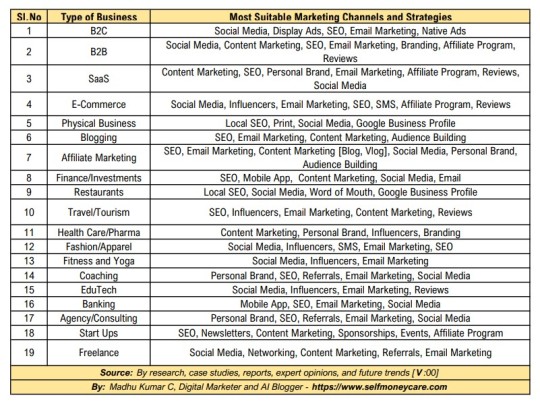
In conclusion, effective marketing is about understanding your audience, crafting a compelling message, choosing the right channels, and measuring the results.
It requires a combination of creativity, data analysis, and strategic thinking.
By implementing these principles, businesses can drive growth, increase brand awareness, and ultimately achieve their marketing objectives.
Here's related information that you may also find helpful – Who Benefits from Marketing?
#effective marketing#marketing strategies#marketing techniques#marketing channels#digital marketing#data driven marketing
0 notes
Text
How B2B Product Marketing Will Evolve in 2025: Strategies for Growth
In the evolving world of B2B marketing, product marketing has become the backbone of ensuring that products not only reach the right audience but also succeed in the competitive landscape. As we head into 2025, B2B product marketing is more data-driven, customer-focused, and aligned with broader marketing strategy than ever before. From understanding customer needs to managing the product lifecycle, marketers have to constantly refine their approaches to stay ahead.
This post dives into a comprehensive breakdown of B2B product marketing, exploring key strategies, insights, and frequently asked questions to help marketers stay at the top of their game.
Get full insights@ https://itechseries.com/blog/b2b-product-marketing-breakdown-2025/
What is B2B Product Marketing, and Why is It Critical?
B2B product marketing is the process of promoting and selling products from one business to another. Unlike B2C marketing, which focuses on individual consumers, B2B marketing involves complex decision-making processes, multiple stakeholders, and longer sales cycles.
Why is it important?
B2B product marketing bridges the gap between the product development team and the sales team. A strong product marketing strategy helps businesses clearly communicate the product’s value to the right audience, ensuring that the product meets the customer’s needs and fits within their budget. Ultimately, it drives revenue by positioning the product as a solution to specific business challenges.

In 2025, product marketing has shifted towards hyper-targeted campaigns, aligning products with specific pain points of businesses, while leveraging technologies like AI to refine messaging and positioning.
What Key Elements Define a Successful Product Marketing Strategy?
Every successful product marketing strategy focuses on aligning the product with market needs, and in B2B marketing, this is more complex due to the nature of the audience. Here are some critical components:
Audience Segmentation: Identifying and segmenting the target audience based on industry, company size, role, and pain points is essential. This ensures that marketing efforts are focused and targeted.
Positioning & Messaging: In a crowded B2B marketplace, how a product is positioned can make or break its success. Crafting clear, compelling messaging that highlights the product’s unique selling propositions (USPs) is vital.
Sales Enablement: B2B marketers must equip sales teams with the tools and content they need to close deals. This can include product demos, case studies, sales decks, and competitor comparisons.
Customer Success: A product marketing strategy doesn’t end when a sale is made. Ensuring the customer succeeds with the product through onboarding, training, and ongoing support is just as important for long-term success.
How Does the Product Lifecycle Impact B2B Product Marketing?
The product lifecycle plays a crucial role in shaping a B2B marketing strategy. As products evolve from development to growth and maturity, the marketing strategy must adapt to meet different goals.
Development Phase: In this phase, marketers focus on identifying market needs and customer pain points. Research and competitor analysis are essential to ensure the product solves real problems.
Launch Phase: Product marketing efforts should build momentum during the launch. This phase requires creating buzz, educating the audience, and providing clear value propositions to the market. Content marketing, webinars, and influencer outreach often play key roles here.
Growth Phase: As the product gains traction, the focus shifts to scaling marketing efforts. Marketers refine messaging based on customer feedback and increase outreach to attract a broader audience.
Maturity Phase: Once the product reaches maturity, the goal is to maintain its market position while fending off competition. Product marketing efforts may involve offering upgrades, new features, or complementary products to sustain interest.
Decline Phase: If a product enters the decline phase, marketing efforts often shift to repositioning or phasing it out in favor of newer solutions. Product marketers play a crucial role in managing this transition without alienating existing customers.
Understanding the product lifecycle helps marketers anticipate the needs of their audience and adjust their tactics accordingly.
Get the technology trends and insights on GTM Library@ https://itechseries.com/gtm-library/
What Role Does Data Play in B2B Product Marketing?
Data is the backbone of modern B2B marketing strategies. With more data available than ever before, product marketers can make informed decisions about targeting, messaging, and product development.
Customer Insights: Data helps marketers understand what customers need, how they use products, and what challenges they face. Customer surveys, feedback forms, and usage data can provide valuable insights into improving marketing efforts.
Campaign Performance: By tracking key performance indicators (KPIs) such as click-through rates (CTR), cost-per-acquisition (CPA), and lead conversion rates, marketers can assess the effectiveness of their campaigns and make necessary adjustments.
Competitive Analysis: Data can also provide insights into what competitors are doing. This allows B2B product marketers to differentiate their products and highlight their unique strengths.
Personalization: As B2B buyers increasingly expect personalized experiences, data-driven insights allow marketers to tailor messaging, offers, and product demonstrations to meet specific needs.
How Can Marketers Ensure Long-Term Success in B2B Product Marketing?
Long-term success in B2B product marketing requires continuous adaptation and alignment with market trends. Here are some strategies for ensuring sustained growth:
Ongoing Market Research: Regularly gathering insights about customer needs, industry changes, and emerging trends helps marketers stay ahead of the curve.
Collaboration Across Teams: Product marketing is inherently cross-functional, involving collaboration with product development, sales, and customer success teams. Building strong communication channels between departments ensures consistency in messaging and execution.
Continuous Improvement: Monitoring the performance of campaigns and product launches helps identify areas for improvement. Marketers should continually test new approaches, optimize messaging, and seek feedback from customers to refine their strategy.
Embracing Innovation: With rapid technological advancements in AI, automation, and analytics, marketers should leverage these tools to enhance their product marketing efforts and gain a competitive edge.
Get your business boost, visit now@ https://itechseries.com/contact-us/
Conclusion
B2B product marketing is the driving force behind product success in 2025. By understanding the complexities of the product lifecycle, leveraging data, and creating a well-rounded marketing strategy, businesses can ensure their products stand out in an increasingly competitive landscape. As we move forward, the integration of innovative tools and a customer-focused approach will be key to achieving sustained growth.
#B2B Product Marketing#Marketing Strategy#Product Lifecycle#Sales Enablement#Marketing Channels#Content Marketing#Customer Success
0 notes
Text
Marketing Strategy to Grow Your Business Globally
Marketing Strategy, In today’s hyper-competitive business landscape, having a robust marketing strategy is essential for any company looking to grow and succeed on a global scale. Whether you’re a startup aiming to make your mark or an established business seeking to expand your footprint, refining and enhancing your marketing strategy can be the difference between stagnation and significant…
#brand awareness#brand positioning#competitive analysis#content marketing#customer engagement#customer experience#data analytics#digital marketing#enhance business growth#global marketing strategy#international markets#marketing automation#marketing channels#SEO strategies#social media marketing
0 notes
Text

Traditional Marketing vs Digital Marketing.
To get best digital marketing services visit our website : https://cloudxinfotech.com/
#Marketing Comparison#Digital Marketing Advantages#marketing channels#digital marketing#traditional marketing
0 notes
Text
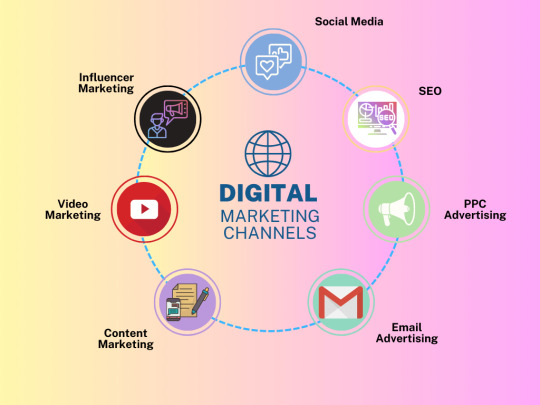
Imagine you want to spread the word about your lemonade stand. Digital marketing channels are like your online tools to reach customers.
Social media: Like chatting with friends on Facebook or Instagram, you can connect with people who might want lemonade.
Search engines: If someone searches for "refreshing drinks," your stand can pop up if it's optimized for search.
Cool content: Eye-catching pictures or a funny video about your lemonade could grab attention.
Emails: Send messages to past customers about new flavors or special offers.
There are other channels too, but these give you a taste of how digital marketing works!
1 note
·
View note
Text
Multichannel Marketing For Customer Retention
Multichannel marketing is a powerful tool for boosting customer retention. By engaging customers across various platforms, you can increase loyalty, drive repeat business, and reduce churn. Continue reading to explore proven strategies and expert insights that will help you retain more customers and grow your business. Importance of Customer RetentionMultichannel Marketing for Customer…

View On WordPress
#customer experience#customer relationship#omnichannel marketing#multichannel marketing#customer retention#marketing strategy#customer loyalty#customer engagement#retention strategies#marketing tactics#cross-channel marketing#digital marketing#brand loyalty#integrated marketing#customer satisfaction#multichannel approach#marketing automation#CRM#marketing channels#customer journey#email marketing#social media marketing#customer lifecycle#data-driven marketing#personalized marketing#customer insights#loyalty programs#marketing campaigns#customer feedback#marketing trends
1 note
·
View note
Text
Unlocking the Power of Digital Marketing: Exploring Different Types
Types of Digital Marketing : In today’s digital age, businesses have a plethora of tools and strategies at their disposal to reach and engage their target audience. Digital marketing has revolutionized the way companies promote their products and services, allowing for precise targeting, measurable results, and enhanced customer interactions. In this blog, we delve into the various types of…

View On WordPress
0 notes
Text
Did You Know? Social Media: A Key Player in Digital Marketing
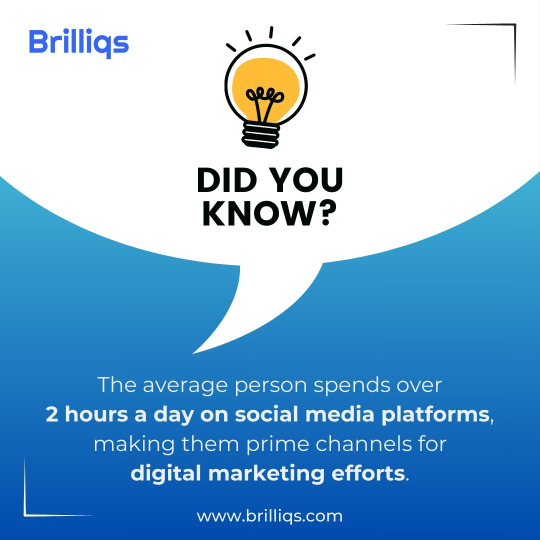
Discover how social media platforms, where the average person spends over 2 hours a day, are crucial for digital marketing efforts. Learn more at Brilliqs - www.brilliqs.com
#Social media marketing#Digital marketing insights#Social media engagement#Marketing channels#Brilliqs
0 notes
Text
How Chance the Rapper Leveraged Technology to Change the Music Industry | by Kabir Virji | Medium






0 notes
Text
What is Digital Marketing?
Digital Marketing is the practice of promoting products or services with the help of digital devices and technology. Digital marketing is also referred as 'online marketing'. Digital marketing began in 1990 and get more used in 2000s. Digital marketing channels can create, accelerate and transmit product value from producer to consumer value through digital networks.

There are different types of Digital marketing channels available namely:
Affiliate marketing
Display advertising
Email marketing
Search engine marketing
Social media marketing
Social networking service
In-game advertising
Online public relations
Video advertising
Content marketing
SMS marketing
Benefits of Digital Marketing
Any information that is needed is accessible at any time or place.
Surpasses internet marketing and also possesses alternatives choices without the internet needed.
Top in presenting beneficial ways and features that reach, inform, engage, offer, and sell services and products to consumers.
Businesses can attain data that present target audiences based on their age, location, interests, and education.
Low investment, the cost per lead is 61% less expensive than traditional marketing.
Able to reach every mobile user, there are over 14 billion worldwide mobile devices and with a projection to grow to almost 18 billion by the year 2024.
1 note
·
View note
Text

Most suitable marketing channels and strategies based on business type
#marketing channels#marketing strategies#digital marketing#internet marketing#seo and online marketing#content marketing#affiliate marketing#social media marketing#blogging
0 notes
Text
Subscribe Digital Paltan on YouTube for Digital marketing
#youtube video#youtube#youtube channel#digitalmarketing#marketingblog#marketingvideo#marketing channels#viralvideos
0 notes
Note
THE STOCK MARKET IS CRASHING

[Image ID: The Destiel confession meme edited so that Dean answers 'The stock market is crashing.' to Cas' 'I love you'. /End ID]
Japan's Nikkei Index fell 12 percent and the Dow Jones industrial average fell more than 1,000 points.
#stock market#stock market crash#dow jones#dow jones industrial average#destiel news channel#supernatural#destiel#spn
317 notes
·
View notes
